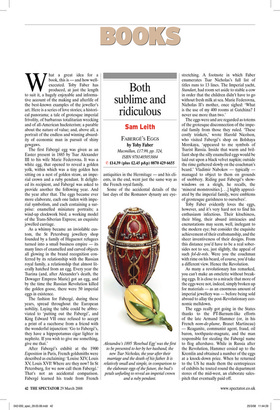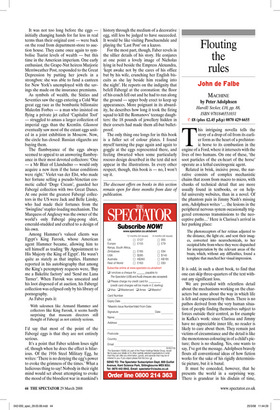Both sublime and ridiculous
Sam Leith
FABERGÉ’S EGGS by Toby Faber Macmillan, £17.99, pp. 324, ISBN 9781405053884 ✆ £14.39 (plus £2.45 p&p) 0870 429 6655 What a great idea for a book, this is — and how wellexecuted. Toby Faber has produced, at just the length to suit it, a hugely enjoyable and informative account of the making and afterlife of the best-known examples of the jeweller’s art. Here is a series of love stories; a historical panorama; a tale of grotesque imperial frivolity, of barbarous totalitarian wrecking and of all-American hucksterism; a parable about the nature of value; and, above all, a portrait of the endless and winning absurdity of economic man in pursuit of shiny gewgaws.
The first Fabergé egg was given as an Easter present in 1885 by Tsar Alexander III to his wife Marie Federovna. It was a white egg, that opened to reveal a golden yolk, within which was a tiny golden hen sitting on a nest of golden straw, an imperial crown and a ruby pendant. It delighted its recipient, and Fabergé was asked to provide another the following year. And the year after that. The eggs became ever more elaborate, each one laden with imperial symbolism, and each containing a surprise: enamelled miniature portraits; a wind-up clockwork bird; a working model of the Trans-Siberian Express; an exquisite jewelled carriage.
As a whimsy became an inviolable custom, the St Petersburg jewellery shop founded by a family of Huguenot refugees turned into a small business empire — its many lines of enamelled and carved objects all glowing in the brand recognition conferred by its relationship with the Russian royal family, a relationship that almost literally hatched from an egg. Every year the Tsarina (and, after Alexander’s death, the Dowager Empress Marie) got an egg, and by the time the Russian Revolution killed the golden goose, there were 50 imperial eggs in existence.
The fashion for Fabergé, during these years, spread throughout the European nobility. Laying the table could be abbreviated to ‘putting out the Fabergé’, and King Edward VII once refused to accept a print of a racehorse from a friend with the wonderful injunction: ‘Go to Fabergé’s, they have a hippopotamus cigar lighter in nephrite. If you wish to give me something, give me that.’ After Fabergé’s exhibit at the 1900 Exposition in Paris, French goldsmiths were described as exclaiming: ‘Louise XIV, Louis XV, Louis XVI! Where are they now? In St Petersburg, for we now call them Fabergé.’ That’s not an accidental comparison. Fabergé learned his trade from French antiquities in the Hermitage — and his clients, in the end, went just the same way as the French royal family.
Some of the accidental details of the last days of the Romanov dynasty are eye stretching. A footnote in which Faber enumerates Tsar Nicholas’s full list of titles runs to 13 lines. The Imperial yacht, Standart, had room set aside to stable a cow in order that the children didn’t have to go without fresh milk at sea. Marie Federovna, Nicholas II’s mother, once sighed: ‘What is the use of my 400 rooms at Gatchina? I never use more than two.’ The eggs were and are regarded as totems of the grotesque disconnection of the imperial family from those they ruled. ‘These costly trinkets,’ wrote Harold Nicolson, who visited Fabergé’s shop on Bolshaya Morskaya, ‘appeared to me symbols of Tsarist Russia. Inside that warm and brilliant shop the silly enamelled eggs would be laid out upon a black velvet napkin; outside the rime gathered slowly on the coachman’s beard.’ Vladimir Nabokov — typically — managed to object to them on grounds of snobbery. Riding past Fabergé’s showwindows on a sleigh, he recalls, the ‘mineral monstrosities [. . .] highly appreciated by the imperial family, were emblems of grostesque garishness to ourselves’.
Toby Faber evidently loves the eggs, however, and it’s very hard not to find his enthusiasm infectious. Their kitschiness, their bling, their absurd intricacies and encrustations may seem, well, inelegant to the modern eye; but consider the exquisite achievement of their craftsmanship, and the sheer inventiveness of their designs. From this distance you’d have to be a real sobersides not to see, just slightly, the appeal of such fol-de-rols. Were you the coachman with rime on his beard, of course, you’d take a different view. Hence the Revolution.
As many a revolutionary has remarked, you can’t make an omelette without breaking eggs. It is close to a miracle that more of the eggs were not, indeed, simply broken up for materials — as an enormous amount of imperial jewellery was — before being sold abroad to allay the post-Revolutionary economic meltdown.
The eggs really got going in the States thanks to the PT-Barnum-like efforts of the late Armand Hammer (or, in his French nom-de-plume, Braset Martineau) — Reaganite, communist agent, fraud, oil baron, toothpaste-magnate, and the man responsible for stealing the Fabergé name to flog aftershave. While in Russia after the Revolution, Hammer cosied up to the Kremlin and obtained a number of the eggs at a knock-down price. When he returned to the US he made them the centrepieces of exhibits he touted round the department stores of the mid-west, an elaborate salespitch that eventually paid off. It was not too long before the eggs — initially changing hands for far less in real terms than their original cost — were back on the road from department-store to auction house. They came once again to symbolise Tsarist levels of wealth — but this time in the American imperium. One early enthusiast, the Grape-Nut heiress Marjorie Merriweather Post, responded to the Great Depression by putting her jewels in a strongbox: she was able to fund a canteen for New York’s unemployed with the savings she made on the insurance premiums.
As symbols of wealth, the Sixties and Seventies saw the eggs entering a Cold War great egg race as the bombastic billionaire Malcolm Forbes — a man who insisted on flying a private jet called ‘Capitalist Tool’ — struggled to amass a larger collection of imperial eggs than the Kremlin. Glasnost eventually saw most of the extant eggs united in a joint exhibition in Moscow. Now, the circle has closed: Russian oligarchs are buying them.
The flamboyance of the eggs always seemed to appeal to an answering flamboyance in their most devoted collectors: ‘One — a Mr Blair of Llandudno — would only acquire a new item if the lunar conditions were right.’ Violet van der Elst, who made her fortune selling a pseudo-Venetian cosmetic called ‘Doge Cream’, guarded her Fabergé collection with two Great Danes. At one point the greatest Fabergé collectors in the US were Jack and Belle Linsky, who had made their fortunes from the ‘Swingline’ stapler-loading mechanism. The Marquess of Anglesey was the owner of the world’s only Fabergé ping-pong shirt, emerald-studded and crafted to a design of his own.
Among Hammer’s valued clients was Egypt’s King Farouk, whose American agent Hammer became, allowing him to sell himself as trading ‘By Appointment to His Majesty the King of Egypt’. He wasn’t quite as stately as that implies. Hammer reported in his autobiography that among the King’s peremptory requests were, ‘Buy me a Bakelite factory’ and ‘Send me Lana Turner’. When Farouk was unseated and his loot disposed of at auction, his Fabergé collection was eclipsed only by his library of pornography.
As Faber puts it:
With salesmen like Armand Hammer and collectors like King Farouk, it seems hardly surprising that museum directors still thought of Fabergé as not entirely serious.
I’d say that most of the point of the Fabergé eggs is that they are not entirely serious.
It’s a point that Faber seldom loses sight of, though when he does the effect is hilarious. Of the 1916 Steel Military Egg, he writes: ‘There is no denying the egg’s power to evoke the grimness of the times.’ What a ludicrous thing to say! Nobody in their right mind would set about attempting to evoke the mood of the bloodiest war in mankind’s history through the medium of a decorative egg, still less be judged to have succeeded. It would be like visiting Passchaendale and playing the ‘Last Post’ on a kazoo.
For the most part, though, Faber revels in the sillier details of his story. He conjures at one point a lovely image of Nicholas lying in bed beside the Empress Alexandra, ‘kept awake not by the cares of his office but by his wife, crunching her English biscuits as she lay beside him reading into the night’. He reports on the indignity that befell Fabergé at the coronation: the floor of his coach fell out and he had to run along the ground — upper body erect to keep up appearances. More poignant in its absurdity, he describes how long it took the firing squad to kill the Romanovs’ teenage daughters: the 18 pounds of jewellery hidden in their corsets had made them all-but bulletproof.
The only thing one longs for in this book is a fuller set of colour plates. I found myself turning the page again and again to goggle at the eggs represented there, and feeling thwarted when some particularly rococo design described in the text did not appear in the illustrations. In every other respect, though, this book is — no, I won’t say it.

















































































 Previous page
Previous page